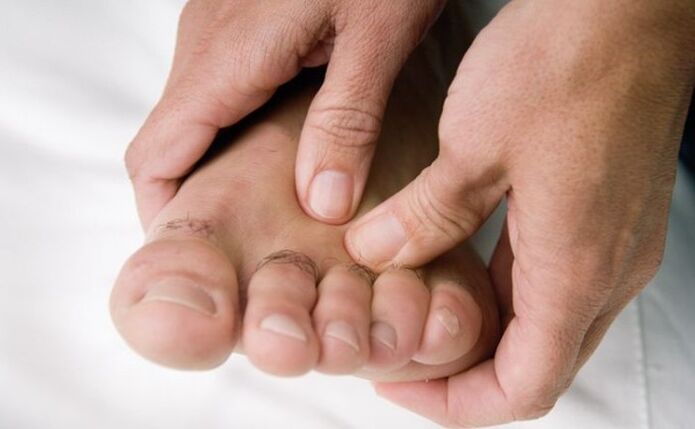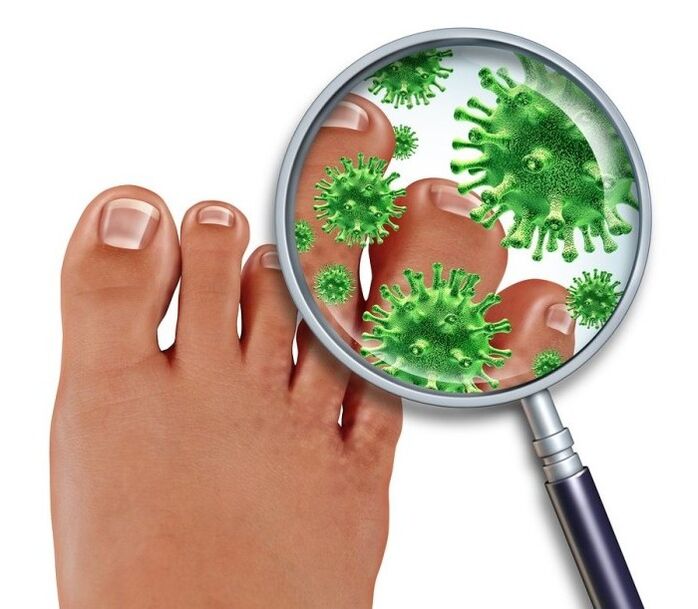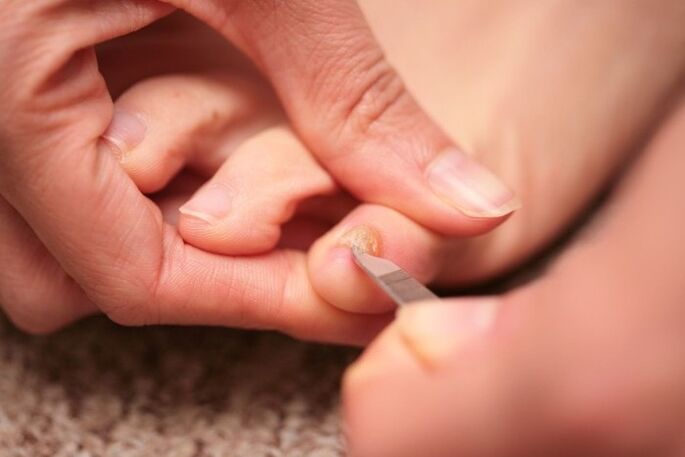The question of how to cure nail fungus is asked by many, but not everyone chooses the right solution to this problem and turns exclusively to traditional medicine. Using homemade products can sometimes be helpful, but it's better to trust the experts and not experiment with your own health.

Another misconception is the assumption that nail fungus is not a serious disease that should be treated immediately, but this is far from the case. Fungi or onychomycoses occur in connection with the spread of bacteria on the horny plate and if they do not prevent their spread, then the infection will penetrate into all surrounding tissues and into the body. In this case, you will have to decide not how soon the nail fungus should be cured, but how to save the limb and overall health.
How the fungus manifests itself
In the initial stages, it is much easier to deal with the infection. It is possible to abandon the use of special therapeutic agents and prevent the destruction of the nail, which leads to complete or partial removal of the horny plate.
In general, anyone who pays attention to their feet and takes care of their toes regularly can find a fungal infection. This is evidenced by the following signs:
- The appearance of areas that differ from the natural color of the nail. What the changes will be depends on the type of infection. These can be light stripes or brown, yellow "dots". There is a possibility of the formation of other nuances, which should be a reason to determine the cause of such changes;
- Fragility. If the toenail is falling apart, flaking, then it's probably time to decide how to cure the nail fungus. In some cases, brittle nails are caused by other diseases, vitamin deficiencies and poor nutrition, so in any case, consultation with a specialist will not hurt;
- Deformation of the horny plate. The growth of bacteria, the lack of treatment leads to significant modifications of the nail, it is noticeably deformed. Not only does the appearance of the foot deteriorate, but there is also discomfort when walking in shoes;
- Itching, soreness in the affected area;
- Bad smell. It is highly undesirable to bring the condition of the nails to the stage when a specific odor is already released, there are signs of suppuration, an inflammatory process. Such symptoms may already indicate not only that it is time to cure the nail fungus, but also to take measures to save the body from the spread of infection.
The signs have different manifestations depending on the development of nail disease, which led to the appropriate classification of mycosis lesions:

- 1st stage. An initial degree that can only be detected by a very careful person or a dermatologist. Minor changes in color, slight itching is possible;
- Stage II. The nail may become deformed, the color changes, the stratum corneum is partially destroyed. It is still possible to cure nail fungus without surgery, but delaying it will only make the situation worse;
- Stage III. It is considered one of the advanced stages of fungal infection. It is no longer necessary to treat only the nail, but possibly the surrounding tissues, as well as the root itself, as at this stage the infection is very deep. Various inflammations, suppurations and so on can become concomitant factors. It is very dangerous to bring the condition of the feet to such an advanced stage, as the treatment will require significant physical and financial costs and there is no guarantee that the restored nail will be even.
What can be the treatment of fungus on the feet
Modern medicines on the market for medical products against various types of infections allow effective treatment of the fungus at home. Depending on the stage, type and degree of infection, it is possible to choose the optimal drug.
In addition, some drugs have a complex effect, their use allows you not only to solve the problem of how to cure nail fungus, but also how to stimulate cell regeneration and accelerate healing.
From the many drugs that are actively advertised, have positive reviews or are simply recommended for nail diseases, the following subgroups can be distinguished:
- Lucky. It is recommended to use the varnish as an additional treatment, for example during a period when it is not possible to use an ointment, compress or other external means. There are varnishes that contribute to the gradual exfoliation of the affected area, which is necessary for better penetration of active compounds to destroy the infection. The main advantage of varnishes is the ability to mask the fungus, as the healing varnish can be temporarily applied decorative varnish. Reviews of such decisions are contradictory; the use of varnish in advanced stages is not recommended;
- Drops. Solutions are applied to the cleaned nail or even after its removal so that the active compounds penetrate the site of infection. It is prescribed together with other drugs if there is significant damage to the nail;
- Ointments and creams. The most diverse range of drugs are ointments and special creams. They differ not only in efficiency, complex action, but also in price. The active ingredients, the concentration and the possible side effects are listed as part of each medicine. Since bacteria that differ in the types of action (yeast, dermatophytes) can provoke the fungus, the methods to deal with them must be chosen accordingly. There are ointments and creams with complex action, ie their use is permissible for various infections. Along with blocking the spread of infection, the ointment can help heal better. The purpose of such drugs is diverse, from the fact that it is recommended to use to remove the nail, and ending with the usual prophylaxis. In this regard, it is better to visit a specialist before use, find out reviews, read the instructions carefully to get rid of the fungus in the near future;
- Plasters. They are mainly used for partial or complete nail removal. In advanced stages, such a procedure is necessary because it is impossible to restore a diseased nail. The patch is impregnated with special substances that slowly dissolve the stratum corneum affected by the infection. After a few applications, it is enough to clean the nail from exfoliated particles and apply a medical ointment. All this is easy to do at home;
- Oral preparations. If the infection has spread not only to one nail, but there is a risk of infection entering the body, then it is recommended to use special drugs. In practice, such treatment is prescribed mainly in stage III. In addition to antifungal suspensions or tablets can be prescribed vitamin-mineral complex to maintain the functions of the whole body, increase the properties of immunity.

In addition to home remedies, you can use hardware to get rid of the fungus. These include laser therapy, cosmetic procedures combined with the application of solutions to eliminate the source of infection, the restoration of the nail in a natural way.
You can choose a drug to treat fungus that has appeared on the nails. This is facilitated by the media, advertising in pharmacies, pharmacist advice, reviews on the Internet. In order not to be misled, the best option is to visit a doctor. But even in this case you can ask for an alternative treatment, as there are funds with a similar composition, but significantly different in price, a complex of actions on the disease.
If the drug is chosen correctly, the improvements will be noticeable after a while. When there is a pulsation, redness, onychomycosis already progresses in other areas, an unpleasant odor becomes noticeable, then you should immediately contact a specialist. In such cases, further self-medication can be dangerous.
Traditional medicine in the fight against nail fungus
A few decades ago, there were no universal remedies for the complex treatment of fungi, there was no way to find reviews of drugs, and then mainly prescriptions from traditional medicine were used. Particularly popular is iodine, which is still an excellent preventive solution against the spread of infections of various origins. Of the most common methods of treating mycosis at home, there are:
- Warm baths. The solutions are prepared with different components, but their action is aimed mainly at softening the affected area, disinfection. A good effect can be achieved with a bath of sea salt, diluted vinegar, celandine, weak potassium permanganate. Each of the options has a certain effect, there is a possibility of allergic reactions. Often after such procedures it is recommended to mechanically clean the nail (with a special brush, pumice), apply iodine or a special medical antifungal drug;
- Vinegar. It is believed that the vinegar solution copes well with such lesions, the most important thing is to dilute the suspension in the right proportions and not to burn the already injured tissues;
- Compresses. A variety of products are used for such procedures. This is baking powder diluted with water, potatoes, garlic, chopped onions, aloe leaves, mouthwash, mountain ash and so on. When doing such experiments, you need to understand a number of serious consequences, including acquired allergies, burns or the most harmless result - no effect;
- Essential oils, herbal decoctions. Essential oil, especially tea tree oil, is a natural antiseptic. It can be used during the treatment period, as well as as a preventive or cosmetic treatment of the feet. Marjoram, eucalyptus oil is also used;
- Salicylic acid can be used to combat onychomycosis, but mainly in the early stages of lesion development.
The possibility of using self-prepared medicines at home is controversial. Because in some such treatment is successful, while in others it leads to prolonged recovery not only of the nail, but also of health in general.
Prevent nail fungus or how not to infect others
Knowing certain rules will help reduce the risk of unpleasant nail infection, as well as protect relatives and other people from infection, if the issue of treatment of mycosis has already been resolved.
The basic rules for protection against fungus and prevention include:
- Regular hygiene, individual washing facilities;
- Use of special slippers in public places (saunas, swimming pools);
- Strengthening the immune system. The weakened organism is unable to fight the infection and the infection spreads;
- Cleaning and periodic disinfection of shoes, especially if the feet often sweat in them;
- The purity of knitwear, they should be changed every day, preference should be given to natural fabrics;
- Wipe your feet thoroughly after water treatments, high humidity provokes the development of fungus;
- Use only your own shoes, clothes;
- Periodic disinfection of pedicure or manicure tools and, of course, only their individual use. If we compare professional cabinets, then special sterilizers are used for these purposes;
- Proper foot care. It is necessary not only to regularly clean the feet with special devices, but additional nourishment of the skin of the feet and nails. If possible, you should visit beauty salons, where professional nail treatment, additional nutrition of the horn plates and skin is performed.
These simple rules, accuracy and attention to your health will help protect you from additional problems with the treatment of mycosis. Such rules must be followed if the disease is already being treated. This will help prevent infecting other people and speed up the healing process.
If a fungal infection has occurred, it may not appear immediately, sometimes after a few months. It is important to detect the formation of an outbreak of infection in a timely manner and to take measures that will help maintain the health and beauty of the feet.
























